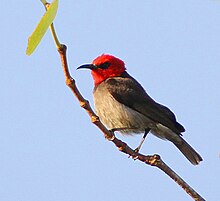
Back Myzomela erythrocephala AST Червеноглав медояд Bulgarian Mel·lífer cap-roig Catalan Myzomela erythrocephala CEB Medosavka červenohlavá Czech Melysor pengoch y mangrof Welsh Myzomela erythrocephala Spanish Myzomela erythrocephala Basque عسلخوار کوتوله سرسرخ Persian Punahuppumesikko Finnish
| Red-headed myzomela | |
|---|---|

| |
| Male perched on a mangrove branch | |
| Scientific classification | |
| Domain: | Eukaryota |
| Kingdom: | Animalia |
| Phylum: | Chordata |
| Class: | Aves |
| Order: | Passeriformes |
| Family: | Meliphagidae |
| Genus: | Myzomela |
| Species: | M. erythrocephala
|
| Binomial name | |
| Myzomela erythrocephala Gould, 1840
| |

| |
| Red-headed myzomela natural range | |
The red-headed myzomela or red-headed honeyeater (Myzomela erythrocephala) is a passerine bird of the honeyeater family Meliphagidae found in Australia, Indonesia, and Papua New Guinea. It was described by John Gould in 1840. Two subspecies are recognised, with the nominate race M. e. erythrocephala distributed around the tropical coastline of Australia, and M. e. infuscata in New Guinea. Though widely distributed, the species is not abundant within this range. While the IUCN lists the Australian population of M. e. infuscata as being near threatened, as a whole the widespread range means that its conservation is of least concern.
At 12 cm (4.7 in), it is a small honeyeater with a short tail and relatively long down-curved bill. It is sexually dimorphic; the male has a glossy red head and brown upperparts and paler grey-brown underparts while the female has predominantly grey-brown plumage. Its natural habitat is subtropical or tropical mangrove forests. It is very active when feeding in the tree canopy, darting from flower to flower and gleaning insects off foliage. It calls constantly as it feeds. While little has been documented on the red-headed myzomela's breeding behaviour, it is recorded as building a small cup-shaped nest in the mangroves and laying two or three oval, white eggs with small red blotches.
- ^ BirdLife International (2016). "Myzomelaerythrocephala". IUCN Red List of Threatened Species. 2016: e.T22703845A93939540. doi:10.2305/IUCN.UK.2016-3.RLTS.T22703845A93939540.en. Retrieved 25 September 2021.
© MMXXIII Rich X Search. We shall prevail. All rights reserved. Rich X Search
